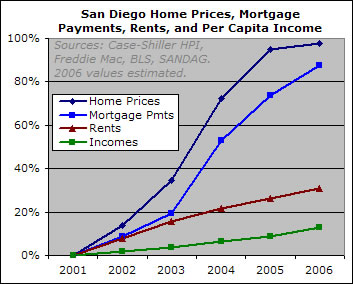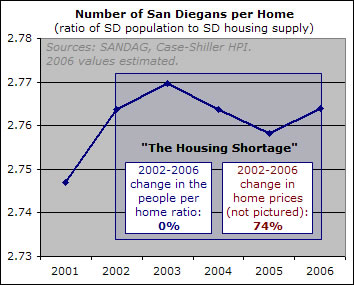By 2001, San Diego had enjoyed a nice housing boom. Since bottoming out in 1996 after a nasty housing downturn, the price of the typical single family home had risen by 74 percent. As of 2001, adjusted for inflation, San Diego homes were more expensive than they’d ever been (at least since the 1970s, which is as far back as the available data goes).
At this point, one might have expected home price growth to slow down or even flatten out. But the show was only getting started. The typical home, already somewhat richly valued, would go on to nearly double in price in just a few years.
Interestingly, this price explosion occurred at a time when rents were growing fairly modestly. This is somewhat strange because the factors that typically drive home prices, such as incomes, employment, and population growth, also affect rents. Yet after 2001, while prices of already richly-valued homes increased 98 percent and the monthly payments on those homes rose 88 percent, rents only increased 31 percent.

Why did home prices and payments rise so much more than rents? There are many explanations for the housing price moonshot, but as we will see below, the evidence supports only one of them.
Let’s go through — one by one — the explanations that do not.
“The housing shortage.” Referred to by the more excitable pundits as the “housing crisis,” this is the crowd favorite. The claim is simple: there aren’t enough places to live, so the homes that are here have become very valuable. Despite the popularity of this idea, though, the San Diego housing supply has actually grown in line with population all along.
Since 2001, according to the San Diego Association of Governments (SANDAG), local population rose 6.7 percent while the housing stock grew by 6.1 percent. This is hardly crisis material to begin with, but the numbers are even less alarming when you consider that virtually all the disparity between population and housing supply occurred from 2001 to 2002. Between 2002 and 2006, population and housing supply both grew by the same amount — 4.8 percent. During this same period San Diego single family home prices rose 74 percent.

The increase in purchase prices over rents might have been justified if the number of rental properties being built had overwhelmed the new supply of homes intended for private ownership. But this certainly doesn’t seem to have been the case — they were, after all, converting apartments into condominiums and not the other way around.
“Everybody wants to live here.” This folksier offshoot of the housing shortage thesis is no more convincing. While San Diego is certainly a nice place to live, it was also nice five years ago when homes cost about half as much as they do now. San Diego’s desirability explains why it costs more to live here than in other areas of the country, not why it costs so much more to live here now than it did just a few years ago. Besides, if the housing boom were a result of some mad dash to move to San Diego, wouldn’t rents have gone up alongside home prices?
“The strong economy.” Leaving aside the fact that a hefty chunk of San Diego’s recent economic growth was owed to the housing boom itself, neither employment nor incomes grew in a particularly dramatic fashion. Since 2001, per the Bureau of Labor Statistics, the number of jobs in the economy grew by 6.7 percent — the same amount as the overall population. According to SANDAG, per capita income rose by 13 percent during the same period. The rise in incomes is absolutely dwarfed by the concurrent increase in home prices (98 percent) and monthly payments (88 percent).
Additionally, as with the other arguments mentioned above, any purported economic strength would not explain why home prices grew so much faster than rents.
“Low interest rates.” Interest rates are fairly low — which makes it that much more amazing that monthly payments have managed to grow in such vast excess of incomes, rents, or anything else that might in bygone days have been considered an economic fundamental.
Further theories are offered up by home price apologists. They speak of an implausibly sudden shift in demographics, a new era of endlessly looser mortgage lending, and any number of other rationalizations that all, in the end, translate to “it’s different this time.” None of these explanations are any more convincing or grounded in factual evidence than those discussed above.
The key to understanding the housing boom really lies in the difference between growth rates of home prices and rents. While one might expect that homes would be more expensive to own than to rent, there is no fundamental reason why the cost difference between renting and owning should have expanded as much as it did since 2001.
The tremendous growth in the premium paid to own a home was driven not by economics or demographics, but by psychology. Over the course of the boom, home ownership became viewed less as a way to simply secure a place to live and more as a means of personal enrichment.
People expected home prices to continue rising, for all the misguided reasons outlined above, and were accordingly willing to pay that much more to get on the real estate gravy train. The increase in demand actually drove up prices, which made buyers even more confident that real estate was the place to be. More optimism led to further price gains, which only reinforced the idea that the original optimism was well placed.
Meanwhile, rising collateral values and extremely low default rates (who could default when homes were providing their owners with a constantly increasing stockpile of equity?) encouraged mortgage lenders to stop worrying so much about how much they lent and to whom they lent it. Such liberal financing allowed exuberant buyers to stretch even further in their attempts to outbid one another for homes, which drove prices and confidence higher still.
This self-reinforcing cycle — higher prices leading to increased buyer and lender confidence leading to even higher prices — ran unchecked until San Diego home prices finally reached a level of unaffordability from which they simply could not be propelled further. And here we sit, with the cycle just having started to shift into reverse.
What happens next is unknown, but what’s happened up until now is crystal clear. San Diego’s stunning home price increases were owed not to fundamentals but to euphoric optimism, excessive risk taking, and increasingly unreasonable expectations of future price gains. This is the very definition of a speculative bubble.
This article was originally written for voiceofsandiego.org, a local news publication that provides continuing coverage of San Diego housing and economic issues.
